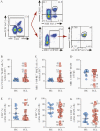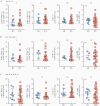Preserved Mucosal-Associated Invariant T-Cell Numbers and Function in Idiopathic CD4 Lymphocytopenia
- PMID: 34398238
- PMCID: PMC8366440
- DOI: 10.1093/infdis/jiaa782
Preserved Mucosal-Associated Invariant T-Cell Numbers and Function in Idiopathic CD4 Lymphocytopenia
Abstract
Background: Mucosal-associated invariant T (MAIT) cells constitute a subset of unconventional, MR1-restricted T cells involved in antimicrobial responses as well as inflammatory, allergic, and autoimmune diseases. Chronic infection and inflammatory disorders as well as immunodeficiencies are often associated with decline and/or dysfunction of MAIT cells.
Methods: We investigated the MAIT cells in patients with idiopathic CD4+ lymphocytopenia (ICL), a syndrome characterized by consistently low CD4 T-cell counts (<300 cell/µL) in the absence of HIV infection or other known immunodeficiency, and by susceptibility to certain opportunistic infections.
Results: The numbers, phenotype, and function of MAIT cells in peripheral blood were preserved in ICL patients compared to healthy controls. Administration of interleukin-7 (IL-7) to ICL patients expanded the CD8+ MAIT-cell subset, with maintained responsiveness and effector functions after IL-7 treatment.
Conclusions: ICL patients maintain normal levels and function of MAIT cells, preserving some antibacterial responses despite the deficiency in CD4+ T cells.
Clinical trials registration: NCT00867269.
Keywords: IL-7; MAIT cells; idiopathic CD4+ lymphocytopenia.
Published by Oxford University Press for the Infectious Diseases Society of America 2020.
Figures





References
Publication types
MeSH terms
Substances
Associated data
Grants and funding
LinkOut - more resources
Full Text Sources
Medical
Research Materials

